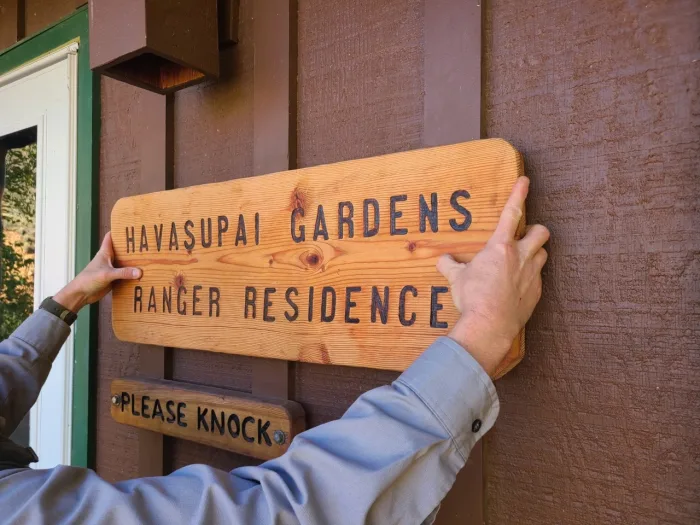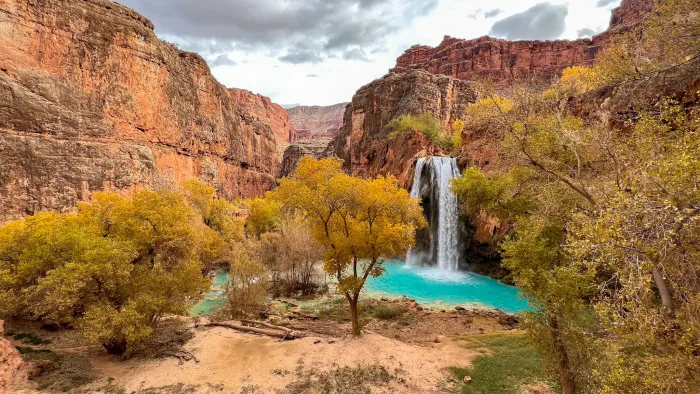Havasupai Tribe marks a spiritual homecoming
‘We are still the Grand Canyon’
Felicia Fonseca
Associated Press

Tourists look out from the South Rim at the Grand Canyon on Thursday, May 4, 2023. The Havasupai Tribe held a blessing ceremony to mark the renaming of a popular campground from Indian Garden to Havasupai Gardens. (AP Photo/Ty O’Neil)
Carletta Tilousi hit the trail as the sun rose, the light revealing a grouping of cottonwood and ash trees deep in the Grand Canyon.
Birds soared above and reptiles scampered across the rocks as the canyon walls grew taller and taller behind her. This was home, yet she rarely had been there over the years.
“I can’t believe how far I’ve come, it’s amazing,” she said about halfway through the 4.5-mile hike over steep, rocky terrain. “I can’t believe my ancestors used to do this all the time.”
The journey was both emotional and celebratory. She remembered the words of her uncle, the late Rex Tilousi, who told stories of Havasupai people being forced out of what’s now Grand Canyon National Park. But that day she was hiking with joy at a pivotal moment in the tribe’s relationship with the National Park Service — headed toward a private ceremony rededicating a popular campground as Havasupai Gardens or “Ha’a Gyoh” in the Havasupai language.
The name change from Indian Garden came in November after the tribe lobbied for years to reclaim a part of its heritage and force a historical reckoning over the treatment of the Havasupai people, the last of whom the park service removed in 1928 from their onetime farmlands.
Descendants of the last Havasupai man to leave, Captain Burro, recall how he carried watermelon in a basket to sell to tourists and how his heart broke when he was ordered to leave. Some family members later changed the name Burro, Spanish for “donkey,” to Tilousi, or “storyteller.”
Park Superintendent Ed Keable acknowledged the removal and sometimes violent injustices over decades on the part of the federal government. Speaking after the ceremony at Havasupai Gardens last Friday, he said the renaming marked a new era of collaboration with Havasupai and other Native American tribes associated with the canyon.
“That took some time to build some trust because of the history of how this land was established as a national park, against the will of the people who have lived here since time immemorial,” Keable said.
The Havasupai Tribe was landless for a time after the removal until the federal government set aside a plot in the depths of the Grand Canyon for tribal citizens. It was slashed to less than a square mile and, nearly a century later, enlarged substantially in 1975 in what was one of the biggest land transfers to a tribe.
Today about 500 of the nearly 770 tribal citizens live in Supai Village on the reservation adjacent to the Grand Canyon, so remote it can be reached only by foot, mule or helicopter.
It’s known for the towering waterfalls that give the Havasupai, or Havasu ‘Baaja, their name — “people of the blue-green waters.” Thousands of tourists from around the world visit annually, providing the tribe’s largest source of income.
Events marking the rededication of Havasupai Gardens began last Thursday, when dozens of tribal members and others gathered for a public event at the South Rim of the Grand Canyon. Dancers from the Guardians of the Grand Canyon, a traditional and multigenerational group, performed, with men wearing ram horns representing the bighorn sheep that roam the canyon, and women carrying woven baskets. Bells on their feet jingled as they moved in a circle.
Many had their faces marked with red ochre, a pigment from the walls of the Grand Canyon that by tradition is tied to everything from a child’s birth and its first steps to protection and as an expression of beauty.
“No matter where we go, where we are, we are still the Grand Canyon,” said Rochelle Tilousi, a great, great, great granddaughter of Burro and a cousin of Carletta Tilousi.
“It is our home, it is our land and it is our well-being,” said another cousin, tribal Vice Chairman Edmond Tilousi.
That evening and the following morning, a smaller group traveled below the rim for the private ceremony, descending 3,000 feet on a hike that typically takes two to four hours. Some went by foot, while others took a quick ride on a helicopter.
Carletta Tilousi trekked steadily along the rocky switchbacks, stopping occasionally to rest and talk to fellow hikers. One said the Havasupai Gardens name would be hard to get used to.
She arrived at Ha’a Gyoh just as the helicopter landed, smiling broadly as a handful of Havasupai got off. She and Ophelia Watahomigie-Corliss introduced themselves to the canyon, greeted the ancient beings in prayer next to a creek and joined others in letting the canyon know it was never forgotten despite the displacement of their people.


“We have always maintained our connection to this place, not by showing or by boasting. It’s just that we came here and we did our prayers, we did our songs on the rim,” said Dianna Sue Uqualla, an elder who participated in the blessing at a small amphitheater off Bright Angel Trail. “Through that, I think the spirits heard and awoke and said, ‘Yes, you are still here.’”
Her brother, Uqualla — who goes by a single name — sat with a drum before a fire pit and next to a set of antlers holding a water-filled gourd, preparing to conduct the ceremony.
He encouraged those present to set aside their egos, to see the canyon as a source of medicine and hear it, feel it. And also to connect to the elements that Havasupai view as relatives — trees, rocks, birds, clouds, wind.
“When your heart is open, it’s a master receiver of everything,” said Uqualla, who had been making monthly pilgrimages to the canyon at each full moon. “What is coming through is the speak of all that is down here.”
A few hikers wandered into the amphitheater, and he assured them that anyone who was there was meant to be.
Kris Siyuja, 14, took seriously his duties over the two days of events, which included untying bundles of sage, carrying a staff and tapping a drum that he said would amplify Havasupai voices.
“One day the grandparents, the parents and some of the family members might pass away, and they’ll just have to carry on that tradition … wearing the headdress, the regalia, and just walking in their footsteps,” Siyuja said of his generation.
As the sage was lit, Uqualla placed red ochre and corn pollen in the fire. Tribal members guided the smoke using a bundle of feathers onto themselves as a blessing. They prayed and sang in Havasupai and in English. Before leaving, they placed a staff on a hillside to honor the spirits.
Some signs nearby already bore the Havasupai Gardens name among the lush landscape that includes a campground and cabins, one of which Keable recently set aside for Havasupai members to use. More signs and programming is planned with history as told by the tribe, according to park officials.
It parallels a broader trend in which the park has been working with nearly a dozen Native American tribes with ties to the Grand Canyon on exhibits, cultural demonstrations and first-person audio and video. The work has gained the attention of other national park units such as the Golden Gate National Recreation Area and Point Reyes National Seashore in California, plus the American Indian Alaska Native Tourism Association, said Jan Balsom, Grand Canyon’s chief of communications, partnerships and external affairs.
“The more of this we have provided, the more the visiting public is interested,” Balsom said.
Carletta Tilousi wants to see more Havasupai involved in shaping how the Grand Canyon and its resources are managed, something that Interior Secretary Deb Haaland, the first Native American Cabinet-level official, has pushed for within federal agencies.
At Ha’a Gyoh, Tilousi imagines a return to traditional farming with apricot trees, melons, corn and sunflowers. She has also pushed for the Havasupai language to be on maps, posters and ranger badges.
The day after her emotional trek, she awoke with a sense of calmness knowing she and others had returned home and the canyon recognized their voices, songs and prayers.
“It was a very growing experience that I’ll probably hold dear to my heart for a long time, and I’d like to return sooner than later,” Tilousi said. “I want to take full advantage of getting to know the trail more, feeling the animals, the air, enjoying the environment.”


